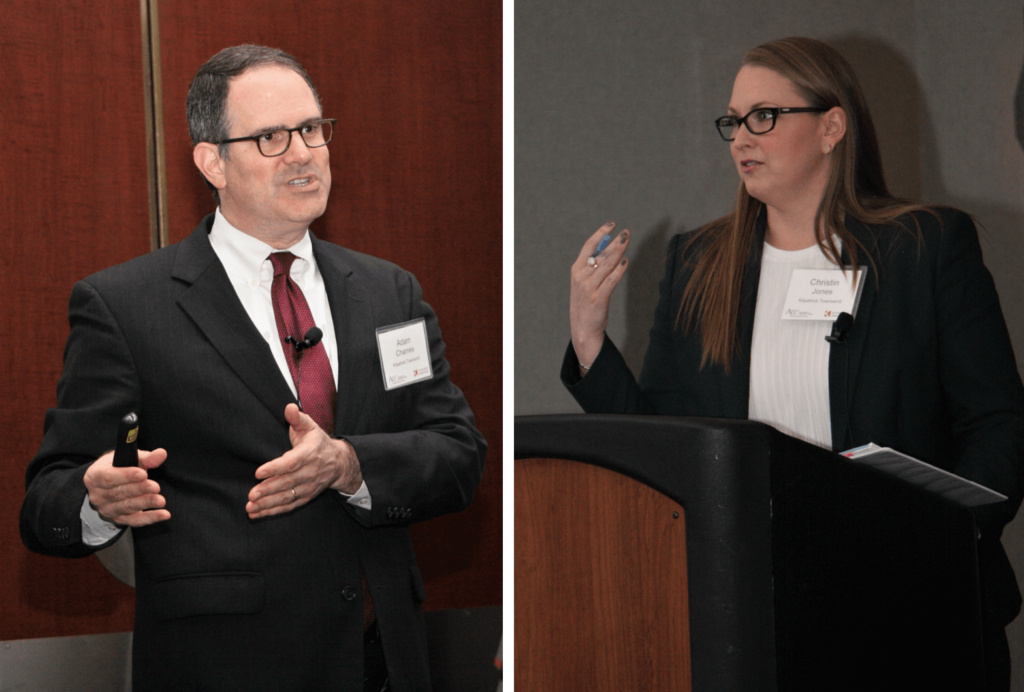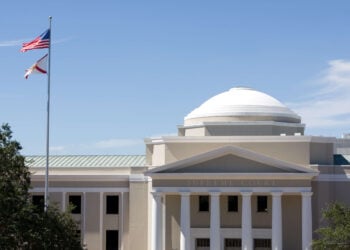The U.S. Supreme Court term that began Monday, October 1 will long be remembered for the bloodbath that ultimately led to Brett Kavanaugh replacing Justice Anthony Kennedy who retired last summer.
Kilpatrick Townsend attorneys Adam Charnes (pictured left) and Christin Jones (pictured right), who advise the firm’s clients on the impact of prior court rulings and the possible impact of pending cases, said it remains to be seen where Justice Kavanaugh may plant his flag on the judicial spectrum.
Charnes and Jones presented a U.S. Supreme Court Update to the Research Triangle Area Chapter of the Association of Corporate Counsel at a CLE in October sponsored by Kilpatrick Townsend.
“Kavanaugh is widely expected to tilt the court more conservative,” said Charnes. “Conservatives on the court are expected to retain their 5-4 edge. It will be interesting to see what impact the confirmation hearings have on Justice Kavanaugh.
“There could be three widely different impacts. One effect could be for him to bend over backward to show, as he said in his speech after the confirmation, that he’s a justice for all the American people and to win over his critics to show he is not political. You could also see the opposite – that he’s polarized by the bitter confirmation process and becomes more conservative than he otherwise would have been.”
“In the last term, the court was very conservative. In fact, the last term was a high-water mark for conservative dominance of the Supreme Court. Nineteen cases were decided by a 5-4 decision, that was 26 percent of its rulings. In 14 of those cases, then-Justice Anthony Kennedy, the traditional swing vote, voted with the four more conservative justices,” said Charnes.
Charnes predicted that the upcoming term would be low key, “The court has a habit of following an exciting, controversial term where they are closely divided and things get a little heated at the end with a term that is calmer.”
However, Charnes noted that Justice Ruth Bader Ginsburg is 85 years old and Justice Stephen Breyer is 80. “Actuarial tables suggest that at some point in the next few years, a president is going to replace these justices and that could dramatically change the court.”
COURT EXPECTED TO BE PRO-BUSINESS
Last year’s ruling in Janus v. AFSCME Council 31 was one of a number of windsock cases in which the Court’s ruling was pro-business according to Jones. The case involved the power of unions to collect fees, known as “agency fees,” from non-union workers in the public sector. While the practice is legal in the private sector, the Court ruled that agency fees in the public sector violate the First Amendment.
“This really shouldn’t have been a surprise to many who follow first amendment opinions because it continues the Supreme Court’s previous trend of invalidating economic regulations through the first amendment,” said Jones.
Another case, South Dakota v. Wayfair, involved sales tax on internet sales. “E-commerce has grown into a significant and vibrant part of our national economy,” wrote Chief Justice John Roberts in dissent. The Court ruled that companies must charge state sales tax even if they do not have a physical presence in a customer’s state.
Most large retailers are already paying these taxes, said Jones. “This really affects mom and pop shops that sell products throughout the country and now must bear the administrative burden of keeping track of sales taxes in all the states they send their items.”
COPYRIGHTS AND PATENTS
One of the cases to be heard in the upcoming term involves whether copyright registration is made when the copyright holder delivers the application to the Copyright Office or only once the Copyright office acts on the application. “It makes a difference because you can’t sue in court until there is copyright registration,” said Charnes.
Another important patent case will look at, “whether under the American Invests Act, an investor’s sale of an invention to a third party that is obligated to keep the information confidential qualifies as a prior art for the purposes of determining the patentability of the invention,” said Charnes.










